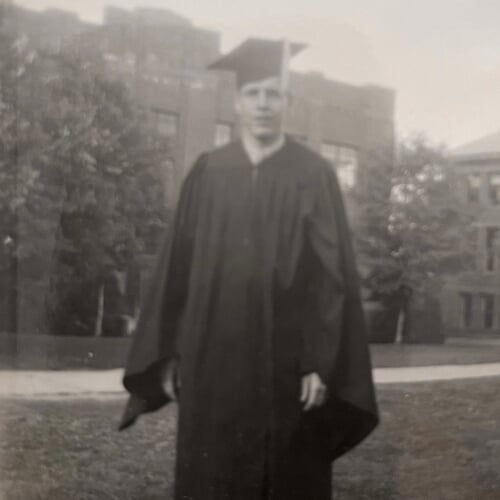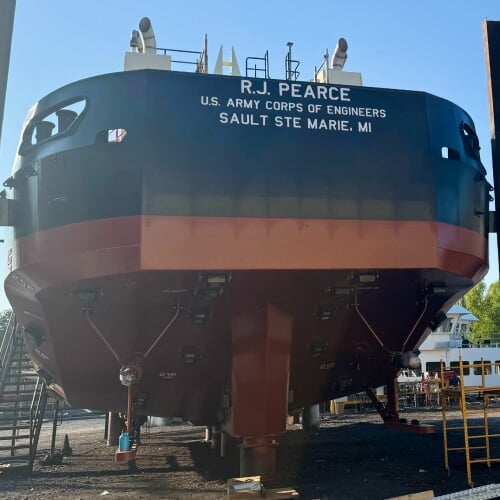Michigan Tech alumnus Ronald Johnston Pearce [1929–2020] had a lifelong connection to the Soo Locks and the St. Marys River in Sault Ste. Marie, Michigan, beginning as a child and encompassing a 35-year career with the U.S. Army Corps of Engineers (USACE). Now, the USACE is honoring his legacy, expertise, and impact on the region with the deployment of the R.J. Pearce—a 76-foot tugboat with a 28-foot beam—that will be commissioned in Sault Ste. Marie this fall.
Growing up in Sault Ste. Marie, Michigan (commonly known as “the Soo”), Pearce’s admiration for the St. Marys River ran deep. As a 13-year-old boy, Pearce remembered returning across the frozen river from neighboring Soo, Canada, when he heard the newsboys shouting that the United States entered World War II following the attack on Pearl Harbor.

Barely a teenager, Pearce joined the war effort by working for the Civil Defense where he would ride his bike in the dark of night to deliver messages to the 15,000 troops who were stationed to protect the locks. The following summers of 1942 and 1944, Pearce ran an outboard and inboard cruiser, respectively, for the boundary surveyor along the river. In 1945, he traveled with the survey from northern Minnesota to New York. He was in Erie, Pennsylvania, on V-J Day, the day that marked the end of World War II.
The opportunity to work at an early age, especially at a tumultuous time in the country, instilled Pearce with a strong work ethic that would transcend throughout his entire life. While he had a long and successful career, Pearce was most well known for his humble integrity and dedication to his family.
Pearce’s collegiate career began in 1946 at Fort Brady—what would become the Sault Ste. Marie Residence Center of the Michigan College of Mining & Technology, and ultimately Lake Superior State University. He transferred to Michigan Tech’s Houghton campus during his third year, and graduated with his Bachelor’s Degree in Mechanical Engineering in 1951.

After graduation, Pearce held positions at the Chicago Northwest Railroad and the International Boundary Commission. He was drafted into the Army in February 1953 and served in Korea from May 1954 through February 1955, where he spent his time rebuilding Korean villages with public buildings, dams, and electric power.
In the summer of 1956, Pearce was accepted into the U.S. Army Corps of Engineers as a civil engineer, returning to the Soo with his wife, Margaret, and their children, Ronald and Sharon—later to be joined by David, Barbara, Ruth, Joseph Edwin, Murray, and Marilynn. Pearce spent 35 years at the St. Marys River Branch and was appointed chief in 1967.
Pearce’s career resulted in mastery of the area and its operations. His expertise was provided in countless projects that still have an impact on the region to this day. In 2009, USACE awarded Pearce the Distinguished Civilian Award because of his work building relationships with stakeholders, managing contracts and surveys, and managing the development and implementation of the acoustic hydrographic survey vessel James Bray. He retired from the USACE in October 1990.
In recognition of Pearce’s lifelong service and dedication to his country and the U.S. Army Corps of Engineers, a new vessel will be named in his honor as the TB Ronald J. Pearce. The tug—with a length of 75 feet, a 28-foot beam, and 9.5-foot drafts when fully loaded—will have the American Bureau of Shipping classification of Maltese Cross A-1 Towing Vessel, Ice Class C0, Great Lakes Service with Maltese Cross AMS and UWild.
The TB Ronald J. Pearce will be used primarily to support marine maintenance activities at the Soo Locks and St. Marys River. The vessel will move crane barges around the lock facilities, supporting material and equipment deliveries for routine and emergency work. Additionally, the boat will move crane, excavator, and material barges up and down the St. Marys River, supporting removal of strikes in the federal navigation channel—a critical function that ensures safe commercial navigation between our Lake Superior ports and the lower Great Lakes, as well as many overseas ports.
The tug captains, engineers, and crews (including members who Pearce previously worked with) traveled to the Lower Atchafalaya River in Morgan City, Louisiana, to witness the first launch, when the TB Ronald J. Pearce was released into the water by sinking the barge and then cutting it loose to float. The vessel will make its maiden voyage to the Soo later this year, traveling around Florida, up the North Atlantic, into the St. Lawrence Seaway, and through the Great Lakes until it reaches Sault Ste. Marie.
March 17, 2025
Michigan Technological University is an R1 public research university founded in 1885 in Houghton, and is home to nearly 7,500 students from more than 60 countries around the world. Consistently ranked among the best universities in the country for return on investment, Michigan's flagship technological university offers more than 120 undergraduate and graduate degree programs in science and technology, engineering, computing, forestry, business, health professions, humanities, mathematics, social sciences, and the arts. The rural campus is situated just miles from Lake Superior in Michigan's Upper Peninsula, offering year-round opportunities for outdoor adventure.





